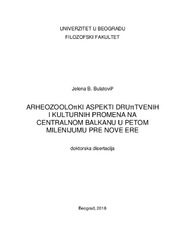Приказ основних података о документу
Arheozoološki aspekti društvenih i kulturnih promena na centralnom Balkanu u petom milenijumu pre nove ere
Archaeozoological aspects of social and cultural changes in the Central Balkans during the fifth millenium BC
| dc.contributor.advisor | Dimitrijević, Vesna | |
| dc.contributor.other | Tasić, Nenad | |
| dc.contributor.other | Porčić, Marko | |
| dc.contributor.other | Ljuština, Marija | |
| dc.creator | Bulatović, Jelena | |
| dc.date.accessioned | 2021-10-12T10:02:04Z | |
| dc.date.available | 2021-10-12T10:02:04Z | |
| dc.date.issued | 2018 | |
| dc.identifier.uri | http://nardus.mpn.gov.rs/handle/123456789/9759 | |
| dc.identifier.uri | http://eteze.bg.ac.rs/application/showtheses?thesesId=5915 | |
| dc.identifier.uri | http://vbs.rs/scripts/cobiss?command=DISPLAY&base=70036&RID=529530519 | |
| dc.identifier.uri | http://reff.f.bg.ac.rs/handle/123456789/80 | |
| dc.description.abstract | Predmet proučavanja ovog istraživanja su arheozoološki aspekti društvenih i kulturnih promena na centralnom Balkanu u petom milenijumu p.n.e. U tu svrhu detaljno je analiziran faunalni materijal sa tri eponimna arheološka nalazišta – Vinča-Belo Brdo, Pločnik i Bubanj. Kako bi se uočilo u kojoj meri se novi podaci uklapaju u postojeća saznanja o ekonomskim strategijama na centralnom Balkanu u ovom periodu, dobijeni rezultati upoređeni su i sa dostupnim podacima iz literature. Cilj istraživanja bio je definisanje ekonomskih strategija eksploatacije domaćih i divljih životinja koje su praktikovane u naseljima Vinča-Belo Brdo, Pločnik i Bubanj; potom, da se istraži da li postoje razlike u ekonomskim strategijama i ulogama najznačajnijih domaćih životinja između ovih naselja, i na kraju, da li se mogu uočiti izvesni dijahroni trendovi i razlike na regionalnom nivou. Istraživanje je ukazalo da se generalno mogu izdvojiti dva tipa strategija u stočarstvu na centralnom Balkanu u petom milenijumu p.n.e. Prvi tip, – koji se zasnivao na uzgajanju govečeta, uočen je samo u velikim kasnovinčanskim naseljima iz prve polovine petog milenijuma p.n.e. (npr. Pločnik, Divostin II, Stubline), dok je drugi tip stočarstva praktikovan u naseljima iz druge polovine petog milenijuma p.n.e. (Bubanj, Velika humska čuka), i kasnije. On se uglavnom zasnivao na uzgajanju ovikaprina, i u značajnoj meri domaćeg govečeta i domaće svinje. Ovakav tip stočarstva verovatno je bio više prilagođen manjim zajednicama iz druge polovine petog milenijuma p.n.e., čiji su proizvodni potencijali bili manji, usmereni ka zadovoljavanju sopstvenih potreba, smanjenju rizika i povećanju bezbednosti uzgajanih stada. S druge strane, stočarstvo u velikim komunalno orijentisanim zajednicama iz prve polovine petog milenijuma p.n.e., bilo je usmereno isključivo ka uzgajanju velikih stada goveda, koje je podrazumevalo drugačiji vid organizacije, veće proizvodne kapacitete i društvene pobude. | sr |
| dc.description.abstract | This thesis addresses archaeozoological aspects of social and cultural changes in the Central Balkans during the fifth millennium BC. For this purpose, detailed analysis of the faunal material from three archaeological type-sites – Vinča-Belo Brdo, Pločnik i Bubanj, was conducted. The obtained results were compared with the available published data, in order to recognize the extent to which these new data fit into the existing knowledge of the economic strategies in the central Balkans during this period. The aim of this research was to define economic strategies for the exploitation of domestic and wild animals that were practiced in the settlements of Vinča-Belo Brdo, Pločnik and Bubanj; then, to detect whether there were changes in the economic strategies and roles of the most important domestic animals among these settlements, and finally, whether certain diachronic trends and differences can be noticed on the regional level. The research has shown that in general, two types of animal husbandry strategies can be distinguished in the central Balkans during the fifth millennium BC. The first type, based on the cattle herding, was only observed in the large late Vinča culture settlements dated to the first half of the fifth millennium BC (f.e. Pločnik, Divostin II, Stubline), while the second type of animal husbandry was practiced in the settlements from the second half of the fifth millennium BC (Bubanj, Velika humska čuka), and onward. It was oriented towards caprines herding, while domestic cattle and domestic pig were also significant. This type of animal husbandry was probably more adapted by smaller communities from the second half of the fifth millennium BC, whose production potentials were smaller, oriented to meet their own needs, to risk reduction and to increase the herd stability. On the other hand, animal husbandry in large communal-oriented settlements from the first half of the fifth millennium BC was oriented to the large cattle herding, which implies a different form of organization, larger production capacities and social incentives. | en |
| dc.language | sr | |
| dc.publisher | Univerzitet u Beogradu, Filozofski fakultet | |
| dc.relation | info:eu-repo/grantAgreement/MESTD/Integrated and Interdisciplinary Research (IIR or III)/47001/RS// | |
| dc.rights | openAccess | |
| dc.rights.uri | https://creativecommons.org/licenses/by-nc/4.0/ | |
| dc.subject | Vinča-Belo Brdo | sr |
| dc.subject | stočarstvo | sr |
| dc.subject | rani eneolit | sr |
| dc.subject | Pločnik | sr |
| dc.subject | peti milenijum p.n.e. | sr |
| dc.subject | kasni neolit | sr |
| dc.subject | ekonomske strategije | sr |
| dc.subject | centralni Balkan | sr |
| dc.subject | Bubanj | sr |
| dc.subject | arheozoologija | sr |
| dc.subject | Vinča-Belo Brdo | en |
| dc.subject | the fifth millennium BC | en |
| dc.subject | Pločnik | en |
| dc.subject | Late Neolithic | en |
| dc.subject | economic strategy | en |
| dc.subject | Early Eneolithic | en |
| dc.subject | central Balkans | en |
| dc.subject | Bubanj | en |
| dc.subject | archaeozoology | en |
| dc.subject | animal husbandry | en |
| dc.title | Arheozoološki aspekti društvenih i kulturnih promena na centralnom Balkanu u petom milenijumu pre nove ere | sr |
| dc.title | Archaeozoological aspects of social and cultural changes in the Central Balkans during the fifth millenium BC | en |
| dc.type | doctoralThesis | |
| dc.rights.license | BY-NC | |
| dc.identifier.fulltext | http://reff.f.bg.ac.rs/bitstream/id/2315/77.pdf | |
| dc.identifier.rcub | https://hdl.handle.net/21.15107/rcub_nardus_9759 | |
| dc.type.version | publishedVersion |

